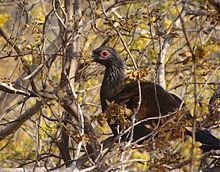Designated February 2, 2004 | ||
 | ||
The Chamela-Cuixmala Biosphere Reserve is a nature reserve on the Pacific coast of the Mexican state of Jalisco. The park was founded in 1993 and covers 131.42 square kilometres in La Huerta Municipality. The land is mountainous and contains dry tropical forest and rolling hills and alluvial plains.
Contents
EtymologyEdit
The name of this protected area is derived from the small town of Chamela, which was an important port centuries ago, and the Cuixmala River, which has the largest of all the rivers in the region and acts as a natural boundary for the reserve.
WildlifeEdit
The forest is characterized by its diversity of flora and fauna and a very high number of endemic species. These include jaguar, puma, ocelot, jaguarundi, coyote, coati, armadillo, skunk, white tailed deer, peccary, American crocodile, geckos, potoos, hawks, kites, storks, vultures, boas, vipers, coral snakes, toads, frogs, sea turtles, opossums, macaws, woodpeckers, etc. In addition, the Pacific Slope region of Mexico and the reserve itself supports a high diversity of neotropical migratory bird species during the winter.
ClimateEdit
Its climate is hot and humid with an annual median temperature of 24.9 degrees Celsius and well-defined seasons. The rainy season lasts from July through October and the dry season is November through June. The median annual precipitation is 748 mm in the hilly Chamela region and 782 mm in the Cuixmala region, which spans from the coast to the mountains.
ProtectionEdit
Both the National Autonomous University of Mexico (UNAM) and the Cuixmala Ecological Foundation, A.C, own most of the land in the reserve. The reserve is threatened by development projects in bordering tracts.
Biological Station UNAMEdit
In 1971, the Biology Institute of the National Autonomous University of Mexico, built a research station.
The main objectives were:
